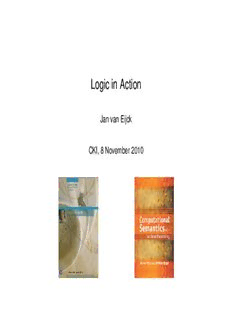
Logic in Action - CWI Amsterdam | Research in mathematics and PDF
Preview Logic in Action - CWI Amsterdam | Research in mathematics and
Logic in Action Jan van Eijck CKI, 8 November 2010 Abstract This talk will provide a tour of lightning visits of applications of logic: • Logic Programming and Functional Programming • Logic in Linguistics • Knowledge Bases • Propositional Logic Theorem Proving • Formal Specification, Software Testing • Puzzle Solving (logical puzzles, sudokus) http://www.logicinaction.org http://www.cambridge.org/vaneijck-unger But First ... http://www.youtube.com/watch?v=OksHblHDij0 Heroes of Logic Programming Heroes of Functional Programming A Brief History of Logic Programming 1930 Jacques Herbrand provides the proof-theoretical basis for automated theorem proving 1965 John Alan Robinson proposes resolution with unification [11] ± 1970 Robert Kowalski proposes a procedural interpretation of Horn clauses. 1972 Alain Colmerauer creates Prolog (with Philippe Roussel) A Brief History of Functional Programming 1932 Alonzo Church presents the lambda calculus 1937 Alan Turing proves that lambda calculus and Turing machines have the same computational power. 1958 John McCarthy starts to implement LISP. 1978-9 Robin Milner cs develop ML. 1987 Agreement on a common standard for lazy purely functional programming: Haskell. http://www.haskell.org A Brief History of Formal Linguistics 1916 Ferdinand de Saussure, Cours de linguistique générale pub- lished posthumously. Natural language may be analyzed as a formal system. 1957 Noam Chomsky, Syntactic Structures, proposes to define natural languages as sets of grammatical sentences, and to study their structure with formal (mathematical) means. Presents a formal grammar for a fragment of English. 1970 Richard Montague, English as a Formal Language, proposes to extend the Chomskyan program to semantics and pragmat- ics. Presents a formal grammar for a fragment of English, in- cluding semantics (rules for computing meanings). Links the study of natural language to the study of formal languages (languages from logic and computer science).
Description: